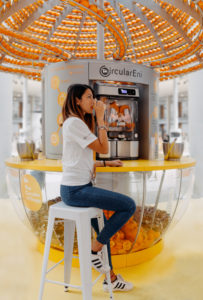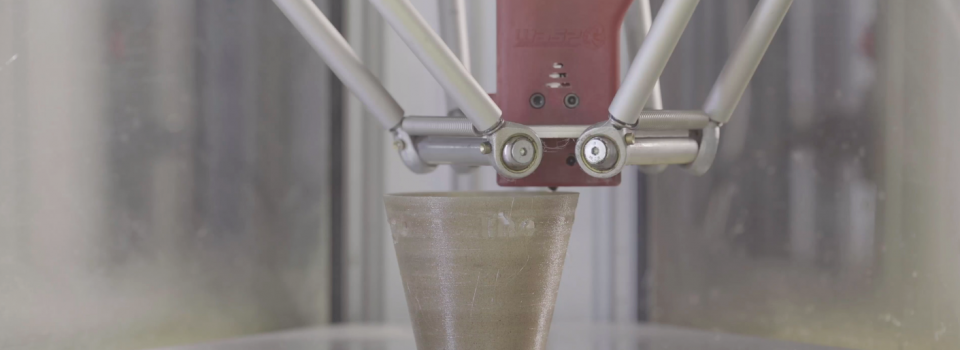Unlocking the value of a circular economy using 3D printing is leading innovation everywhere. Recovery initiatives to increase sustainability, like reusing plastic waste and turning it into 3D printing filament, are becoming more common. In tune with the need to care for Earth’s limited resources, Italian studio Carlo Ratti Associati (CRA), in partnership with global energy company Eni, has developed an orange juice bar that turns waste fruit peel (and added PLA) into 3D printed bioplastic cups to drink the freshly-squeezed juice.
The prototype orange-squeezing machine, called Feel The Peel, uses oranges to make bioplastic, turns it into filament, and then 3D prints disposable cups to drink the juice. After premiering at the 40th Annual Rimini Meeting for friendship among peoples, the Circular Juice Bar was also installed at the Singularity University Summit in Milan last October and at Ecomondo Rimini in November, the leading event in Europe for the new models of the circular economy.
3DPrint.com spoke to Alessandro Tassinari, Head of Digital Prototyping and Fabrication at CRA, one of the minds behind the 3.10-meter-tall experimental juice bar with a circular dome that can hold up to 1,500 oranges. According to Tassinari, the idea was conceived by CRA for Eni in order to spark a debate around innovation and the circular economy: “We wanted to do this in a refreshing way.”
“Sometimes it’s not easy to understand how a technological process works, so usually, the best way is to physically show it to people starting from everyday actions. Everyone knows what makes orange juice entails: you get a lot of orange peels as waste! Starting from this simple concept, we developed a machine that gives organic waste – orange peels in this case – a new lease on life.”
The Circular Juice Bar incorporates the traditional FDM technology that WASP provides with its 3D printers, suggests Tassinari. The 3D printer Delta WASP 2040 INDUSTRIAL 4.0 actually resides in the middle of the juice bar and visitors can watch as their cup is created and then filled with juice. He went on to say that the firm “wanted to use the most affordable, easy-to-use technology to 3D print our material, so we decided to partner with one of the most trusted Italian 3D printer manufacturers.”
“Of course, this didn’t happen automatically: we had to go through a high number of compatibility tests to ensure we would be able to print what we needed. The process behind the Circular Juice Bar is quite simple, but it needs a good execution to be successful,” said Tassinari. “First, we take the orange peels and we dry them. Then, we grind them until we obtain a very fine powder, which is mixed with a specific quantity of polylactic acid pellets and put inside a plastic filament extruder. The filament extrusion process happens in-house, using a Felfil Evo extruder. Once extruded, the filament is spooled in 500g spools and it is ready to be loaded onto our 3D printers. Everything is about timing and about mixing materials in the right amount.”
The Italian studio, led by Carlo Ratti, who is also director of the Senseable City Lab at the Massachusetts Institute of Technology (MIT), developed the orange squeezer to understand how oranges can be used well beyond their juice. Ratti originally suggested that “in the next iterations of these projects, we might add new functions, such as printing fabric for clothing”.
So, how long does it take to dry, mill and 3D print the cup? Tassinari explained that it all depends on the quantity of material that you want to produce.
“At this stage, since the machine is still a prototype and we are very much in a research phase, the process is quite time-consuming. For example, to produce one kilogram of filament, it takes six hours to dry the peels and 20 minutes to mill them, while the extrusion process takes about eight hours and it takes about 15 minutes to 3D print a cup. For the purposes of the Circular Juice Bar, we didn’t focus on production times, instead, our primary target was to find the best chemical composition for the filament so that it would be easy to use. Now we are optimizing the process and we intend to make it faster and less energy-intensive.”
There were many reasons why the creators chose polylactic acid as a chemical base for their material: “mostly because it is one of the cheapest 3D printing materials, it is easy to use, everyone in the 3D printing industry is familiar with it, and most importantly, it is compostable.” This is of course not always the case with PLA itself only being compostable under specific conditions. The objects produced with their orange peel material can be composted through an industrial process, just like organic waste, claims Tassinari, and best of all, the cups can be used more than once: they look and feel like thick plastic cups.
With such a novel development, it is no wonder the studio has received a lot of interest from companies around the world that might be interested in further developing the prototype. Yet, they state it’s too early to say at this stage whether they will manufacture and sell the development. Tassinari proposes that “we would love to eventually push the concept forward, optimizing the process and moving it completely inside the machine.”
Like every other compostable material, the biopolymer made out of orange peels can be used to produce a more sustainable version of objects that aren’t supposed to last forever, such as packaging and disposable products. Plus, the studio could even try using other kinds of fruit that would work just as well. Tassinari indicates that “it’s only a matter of finding the right composition and extruding the resulting filament correctly.”
Designing authentic and genuinely innovative creations out of waste is one of the best ways the Carlo Ratti studio is collaborating to improve our life on Earth. Brilliant collaborations, like the Circular Juice Bar, are getting noticed worldwide as they lead the way to discover new materials that can be used for 3D printing, a method which is already churning the power of sustainability. It would be even better to see these different ideas move faster instead of just being unattainable architectural machines audiences can only see at a few conferences every year.
Join the discussion of this and other 3D printing topics at 3DPrintBoard.com.
Subscribe to Our Email Newsletter
Stay up-to-date on all the latest news from the 3D printing industry and receive information and offers from third party vendors.
You May Also Like
UpNano Launches 2PP 3D Printing Service with New NanoPro VT Printer
UpNano, an Austrian company specializing in two-photon polymerization (2PP) additive manufacturing (AM), has launched a service bureau that will offer high-volume output of microscale parts. The new service, NanoPro, will...
Materialise Updates Magics and Partners with BLT at Formnext 2024
At this year’s Formnext, 3D printing software and services pioneer Materialise, unveiled a series of software updates designed to enhance customization capabilities in 3D printing for its users. The announcement...
HP’s New Materials, Tools, and Collaborations to Drive 3D Printing Forward at Formnext 2024
At Formnext 2024, HP unveiled several key developments aimed at advancing additive manufacturing (AM), with new materials, workflow optimization tools, and expanded metal printing capabilities. These announcements reinforce HP’s strategy...
Farsoon at Formnext: What’s New in 3D Printing for 2024
With Formnext 2024 underway in Frankfurt, Farsoon Technologies (SHA: 688433) is showcasing a series of developments unveiled in the lead-up to the event. From advancing food-safe 3D printing for the...







































